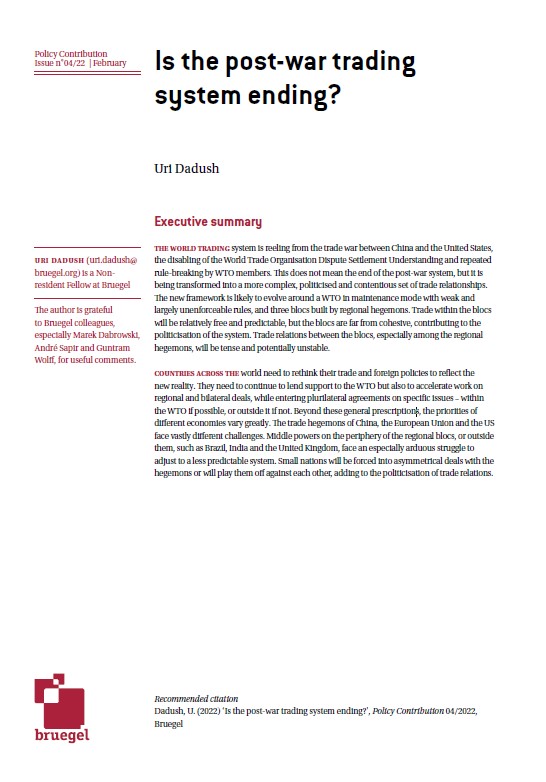Blog Post
Trade wars: Just how exposed are EU Member States and industries to the US market?
This blog focuses on how a more restricted access to US final demand could affect EU economies and sectors, by measuring their share of value-added absorbed in the US. The exposure of the EU as a whole in value-added terms is lower compared to that suggested by gross exports to GDP and, overall, gross exports misconstrue the picture of spill-overs through trade linkages. For individual countries, the degree to which gross exports overestimate or underestimate exposure is relatively small, with the important exception of Ireland. However, gross exports significantly overestimate the exposure of EU manufacturing to US final demand.
Please note this blog is accompanied by an online technical appendix
How much do EU Member States and industries depend on being able to reach the US consumers with their goods and services?
A simple way of addressing this question is to look at each country’s and sector’s bilateral exports to the US as a share of its GDP, shown in Figure 1.
However, this approach disregards the complexity of global trade emanating from cross-border production sharing and trade in intermediates.
An alternative approach that is more intuitive and increasingly popular is to focus on value-added trade flows, i.e. the value of output sold abroad, minus the value of intermediates used in its production. In this particular case we use an approach that differentiates value-added according to its source and final destination in terms of absorption (consumption of final goods); it accounts for all the possible ways, direct and indirect, that value created in the EU ends up in US consumption of final goods, irrespective of how it finds its way there (forward linkages). The latter is relevant when the prospect of the US imposing multilateral tariffs (and not only bilateral vis-à-vis the EU) is likely.
To implement it, we use world input-output tables (WIOT) from the World Input-Output Database (Timmer et al., 2015). WIOT combine national supply and use tables with bilateral trade data. They deconstruct output produced into intermediate supply and final consumption of goods and services across the world. The latest available WIOT (2014) cover 43 countries in total, including all EU28 countries (as well as a model for the rest of the world), and 56 detailed sectors (see Technical appendix below).
Among EU countries, Ireland is still the most exposed but roughly 7.8% of aggregate domestic value-added (i.e. GDP) ends up in final goods and services purchased in the US (Figure 2). While arguably this is a lot, Ireland’s exposure measured in value-added terms is about half of that derived from gross bilateral exports (amounting to approximately 13.5% of GDP). The value-added figures also show relatively large exposures to US demand for Germany, the Netherlands and Belgium, to the tune of 3.5% of the GDP. On the other hand, Spain, Greece, Cyprus, and Malta are the least vulnerable to US final consumption. Large countries such as France and Italy sit in the middle of these extremes at around 2%.
The exposure of the EU as a whole to US demand in value-added terms is lower compared to that suggested by gross exports to GDP. For individual countries other than Ireland, gross flows overestimate exposure to US consumption most for Lithuania (+1.3 pp.) and Belgium (+1.2 pp.). The contrary is true especially for Luxembourg (-1.7 pp.), Slovenia (-0.8 pp.), and Cyprus (-0.7 pp.).
Turning to industries, the differences between value-added and gross export measures are substantially magnified. This is primarily driven by the structure of supply chains across industries (but also countries, e.g. outsourcing). Consider value-added exports first (Table 1): EU manufacturers of pharmaceutical products are the most exposed, with 10% of their value-added absorbed by US final demand, followed by manufacturers of chemicals and motor vehicles (9.6% and 9.4%, respectively). On the other hand, although the composition of the ten most exposed sectors is virtually unchanged, the magnitude of exposure measured by gross exports (Table 2) is much higher (it doubles on average). This is the effect of intermediate trade and global value chains, which is predominant in manufacturing.
To illustrate, the share of gross exports to the US in sectoral value-added (GDP) for the manufacturing of motor vehicles amounts to 23%; for pharmaceuticals manufacturing it stands at 18%; and for the manufacturing of chemical products it is 19%. Moreover, interpreting gross exports as exposure would point to about a third of the value-added of EU manufacturing of coke and petroleum products being ultimately dependent on US final demand; actually, only about 6% of the value-added of that EU sector is US-bound.[1]
To conclude, gross exports as measures of exposure through trade linkages misconstrue the picture of spill-overs. The Irish economy depends largely on US demand but only to the tune of 8% of its value-added, not 13%. The distortion is more serious for the different sectors: e.g. rather than a quarter, only about a tenth of motor vehicle manufacturing’s value-added ends up in US final consumption. These levels of exposure are still significant, but the difference compared to their more readily available gross export counterparts is far from negligible.
Certainly, one cannot use these value-added figures to say what the general equilibrium effect of multilateral tariffs imposed by the US would be. But one can form a more accurate picture of how the shock of the US market becoming less accessible to foreign trade would reverberate into the global production network, and what would be the gravity of that shock for specific economies and sectors.
[1] Note that EU value-added not only depends on US final consumption, but also on US demand for intermediates, as a “bridge” to reach third countries. However, depending on how substitutable are those intermediates, there is the possibility of trade diversion, if the US market becomes less accessible.
References
Timmer, M. P., Dietzenbacher, E., Los, B., Stehrer, R. and de Vries, G. J. (2015), “An Illustrated User Guide to the World Input–Output Database: the Case of Global Automotive Production”, Review of International Economics., 23: 575–605
Quast, B., and V. Kummritz (2015). “decompr: Global value chain decomposition in R”. No. 01-2015. Centre for Trade and Economic Integration, The Graduate Institute.
Wang, Z., S.-J. Wei and K. Zhu (2014): “Quantifying International Production Sharing at the Bilateral and Sector Levels”, Office of Economics of the U.S. International Trade Commission, Working Paper No. 2014-04A.
Republishing and referencing
Bruegel considers itself a public good and takes no institutional standpoint. Anyone is free to republish and/or quote this post without prior consent. Please provide a full reference, clearly stating Bruegel and the relevant author as the source, and include a prominent hyperlink to the original post.












